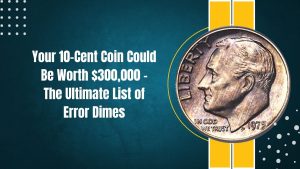Mint error quarters are a captivating niche in numismatics, with certain rare specimens fetching up to $100,000 at auctions. These errors, resulting from anomalies during the minting process, create unique coins that are highly sought after by collectors. This article delves into the top three mint error quarters that you might overlook, providing detailed insights into their origins, distinctive features, and market values.
Contents
1. 2004-D Wisconsin State Quarter – Extra Leaf Error
In 2004, the U.S. Mint released the Wisconsin state quarter as part of the 50 State Quarters Program. Some of these quarters exhibit an extra leaf on the ear of corn depicted on the reverse side, resulting from a die gouge during production. There are two variations: the “High Leaf” and the “Low Leaf,” each adding a unique element to the coin’s design.
- Distinctive Features: The “High Leaf” variety shows an extra leaf above the primary leaf, while the “Low Leaf” variety displays an additional leaf below.
- Market Value: Depending on condition and rarity, these error coins have been known to sell for up to $100,000.
2. 2005-P Kansas State Quarter – “In God We Rust” Error
The Kansas state quarter, minted in 2005, is infamous for a minting error where the phrase “In God We Trust” appears as “In God We Rust.” This anomaly is due to a grease-filled die, causing the “T” in “Trust” to be faint or missing.
- Distinctive Features: The missing or faint “T” in “Trust” on the obverse side is the primary indicator of this error.
- Market Value: While not as valuable as the Wisconsin error, high-grade specimens of this quarter can fetch significant amounts, with some selling for several thousand dollars.
3. 1999-P Delaware State Quarter – “Spitting Horse” Error
The first coin in the 50 State Quarters series, the Delaware quarter, features Caesar Rodney on horseback. Some of these coins exhibit a die crack extending from the horse’s mouth toward the edge, giving the appearance of the horse “spitting.”
- Distinctive Features: A raised line (die crack) emanating from the horse’s mouth toward the rim on the obverse side.
- Market Value: Depending on the coin’s condition and the prominence of the error, these quarters can sell for hundreds to thousands of dollars.
| Quarter | Error Description | Estimated Value |
|---|---|---|
| 2004-D Wisconsin State Quarter | Extra “High” or “Low” leaf on corn | Up to $100,000 |
| 2005-P Kansas State Quarter | “In God We Rust” due to grease-filled die | Several thousand dollars |
| 1999-P Delaware State Quarter | “Spitting Horse” die crack | Hundreds to thousands of dollars |
Understanding Mint Errors
Mint errors occur during the coin production process and can include die cracks, grease-filled dies, and die gouges. These imperfections result in unique coins that deviate from standard designs, making them highly collectible.
Factors Influencing Value
The value of mint error quarters depends on several factors:
- Rarity: The fewer error coins available, the higher their value.
- Condition: Coins in mint or uncirculated condition command higher prices.
- Prominence of Error: More noticeable errors are typically more valuable.
Identifying Mint Error Quarters
To identify potential mint error quarters:
- Examine Coins Closely: Use a magnifying glass to spot anomalies in design elements.
- Compare with Standard Coins: Familiarize yourself with standard designs to detect deviations.
- Consult Experts: Seek professional evaluation for confirmation.
Mint error quarters like the 2004-D Wisconsin “Extra Leaf,” 2005-P Kansas “In God We Rust,” and 1999-P Delaware “Spitting Horse” are valuable treasures often overlooked in everyday change. By paying close attention to the coins you encounter, you might discover a rare mint error quarter worth a substantial sum.
FAQs
What causes mint errors on quarters?
Mint errors result from anomalies during the coin production process, such as die cracks, grease-filled dies, or die gouges.
How can I determine the value of a mint error quarter?
The value depends on factors like rarity, condition, and the prominence of the error. Consulting a professional coin appraiser is recommended.
Are mint error quarters legal tender?
Yes, mint error quarters are legal tender, but their collectible value often exceeds their face value.
Where can I sell a mint error quarter?
You can sell them through coin dealers, auctions, or online marketplaces specializing in collectible coins.
How do I protect and store valuable error coins?
Store them in protective coin holders and keep them in a cool, dry place to preserve their condition.







